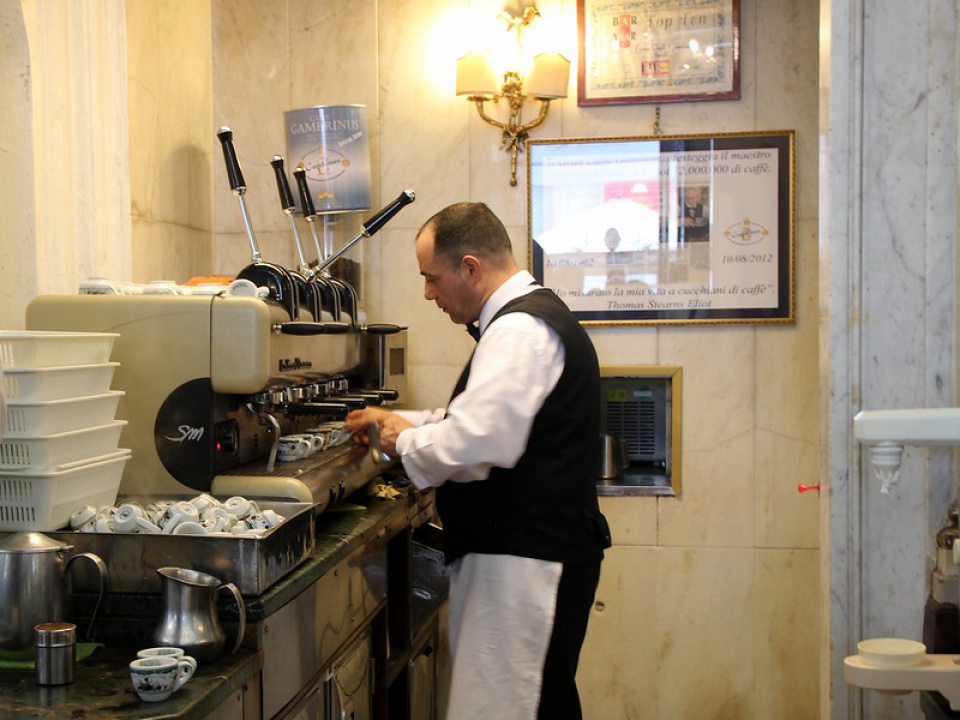
pic @Bex.Walton Caffè Gambrinus
History has it that coffee was introduced in Napoli by the Archduchess Marie Caroline of Hapsburg, yes that Carolina we give credit for also introducing to Italians the bidet, as we already know. Kaffee was a very fashionable drink in Austria, not only among the Court and nobility but within the reach of the wealthy bourgeois in the numerous chic Wiener kaffeehaeuser. The young Archduchess married Ferdinand IV of Bourbon, King of Naples and Sicily, and in 1768 moved to Naples only to discover coffee was ill-regarded: strong was the power and influence of the Church and local Clergy, which considered coffee to be the devil’s drink and bearer of the evil eye, due to its color and its exciting properties. The young fashionista Queen couldn’t care more: at a court ball in 1771 she organised a coffee room in the Reggia di Caserta, and had cups of coffee served by waiters in white jackets and gloves, ahead of their time baristas. Reality is that it took another 30 years to see the first café opening its doors to Neapolitans and the only surviving café of that grand era is Caffè Gambrinus, which opened in 1860 as Gran Caffè, facing the north corner of the Royal Palace.
Compared to other Italian cities, Naples has a distinct coffee culture which seems to have stopped in the 1950s, when finally, coffee became a popular drink throughout the urban classes. Unlike the rest of Italy in Naples the homely coffee maker is not the Bialetti’s mokka pot but the coccumella, invented by a French but so widely adopted in Naples that is also called napoletana. The great Edoardo De Filippo already said everything about this and I don't even dare to add a word. Check out here is ardent monologue out of Questi Fantasmi movie of 1954.
If in a Trieste cafe, to feel like a local what really matter is the , in Napoli the eccentricities go beyond the act of correctly ordering your cup of coffee: having an espresso in Naples seems to follow an unspoken script whose fundamental steps cannot be avoided. As you enter any Neapolitan café you’ll notice the espresso machine are not sleek and slender, with electronic buttons as the modern ones you can find in other parts of Italy, rather the machines are quite old-fashioned with big baton-like manual levers. If you opt for a caffè al volo (on the go), like locals do, standing at the counter, your order will be taken by the cashier, who will “call” your espresso or capuccino to the barista. As you approach the counter the barista will serve you first a miniature glass of water, whose purpose is to clean your palate and prepare it for your caffeine shot. Next comes your coffee, served on a hot, almost scalding cup because the espresso, like pizza, has a few moments of life and when lukewarm or, worse, cold it becomes something undrinkable for Neapolitans. If you order something to eat with your espresso then expect your hot cup to be served once you have finished eating. Once again, the reason is to avoid you to drink it cold. Same happens if you order a cappuccino, so if you like to soak your sfogliatella or cornetto in it, then, better you tell the barista you like to have both served together. Lastly never forget to compliment your barista and possibly leave a small tip. Next time you’ll enter that café you’ll be recognised and you’ll be greeted and really feel like a local.
“Prendiamoci un caffè”, let’s have a coffee, is probably the most common way of saying “let's meet and spend some time (what is necessary but not too long) together”. Having a coffee together is the first approach to any type of relationship, the first moments in which we study, exchange opinions, reveal each other. Those few minutes are essential for the future of the relationship. It is no coincidence that to say you don’t like a person, in Italian we say “con quello nemmeno un caffè” (with that person, I won’t even have a coffee). Coffee is not just the drink, in Napoli, more than any other place in Italy it is one of the most important ways to relate, valid at all hours of the day. Whenever you are invited to have a coffee, it is polite to always answer yes, even if you don't want it, and as you arrive in front of the counter or seat at the table, the question will finally become precise and the immaterial finally materialises: " So, what do you get?”.
After the Art of Neapolitan Pizzaiolo, inscribed in the list of Intangible Cultural Heritage of Humanity by UNESCO in 2017, the Campania region in 2020 has bid for the “Neapolitan Espresso Culture” to be included in that heritage list as well, with the following motivation: "Coffee in Italy is not only a dink, but it expresses a true culture, an entirely Neapolitan ritual that has given birth to traditions spread everywhere, such as that of caffè sospeso that evokes the sense of hospitality, solidarity and conviviality".
The tradition of caffe sospeso (suspended coffee) is born in Napoli and it consists in paying two coffees, one for you and one for a future customer, who cannot afford it. Although the origin of caffè sospeso are not clear, the first to describe it was Luciano De Crescenzo, a prolific Neapolitan writer and populariser with his gentle and elegant manners in “Il Caffè Sospeso” in 1977: “Once in Naples, in the Sanità district, when one was happy because something had gone well, instead of paying for just his coffee, he paid for two, leaving the second one, already paid for, for the next customer. The gesture was called "caffè sospeso". Then, from time to time, a poor man appeared to ask if there was a "sospeso". It was a way like any other to offer a coffee to rest of the world ".
